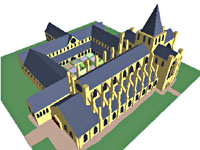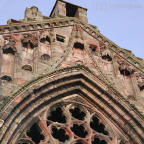|





Cistercian
Founded 1136 by David I
WHEN monks of the Cistercian order were invited to Scotland by King David
they were offered a site at a place called Mailros. However, they decided
it did not meet their needs, and instead opted for a site nearby known as
Little Fordell, which they renamed Mailros. Unusually, the monastery
complex is laid out to the north of the church instead of the south.
The house became very affluent through exercise of their strict Rule of St
Benedict, which emphasised total poverty and extreme hard work -
particularly agricultural development, for which the Order was renowned.
In fact, Melrose became one of the Western world's biggest producers of
wool.
The house was associated with several kings and nobles. King Alexander II
was buried there. King Robert Bruce, who had close associations with
Melrose, gave instructions for his heart to be taken on crusade and then
brought to rest in the abbey, saying his heart had always been there. A
lead casket discovered in 1921 is thought to contain the Hero-King's
mummified heart. James IV used the abbey as a base for his Borders
campaign in the 1490s.
With its rich estates and influence Melrose was a specific target for
English raids. Severe damage was done in 1296 and 1322, but the worst came
in 1385 when Richard II reduced the abbey to ruins. The complex was almost
started from scratch again, and this time the Cistercians built in a
lavishly decorative fashion. Enough of the abbey remains to gain an
impression of the rich detail to be found on every wall and gable.
In 1544 Melrose was once again burnt down by the English in the Rough
Wooing campaign. Only a few dozen monks remained, and they were not able
to rebuild after this attack. Later they complained to Commendator
Stewart: "without the kirk being repaired this instant summer, God-service
will cease this winter." But four years later the Reformation came, and
the Cistercian form of God-service ceased at Melrose for ever.
The complex was secularised in 1609 and the following year the church was
adapted for continued parish use, and the other properties of Melrose sold
by the Crown. The remains of this adaptation are visible today. The
difference between the light airy remains of the monk's choir and the dark
overbearing Protestant development is stark.
That part of the abbey remained in use until 1810, when a new parish
church was built and the ruins were abandoned.
This text is abbreviated
from the articles that appear on ScotlandPast's CD-Rom digital guide "The
Border Abbeys". The guide also features 360 degree panoramic images, photo
galleries, video introductions, 3D interactive graphics and an at-a-glance
history timeline. The CD, which runs on PC and Mac with most Internet
browsers, is available for £8.99 from
http://www.scotland-past.com ©2003 ScotlandPast. All rights reserved. |
